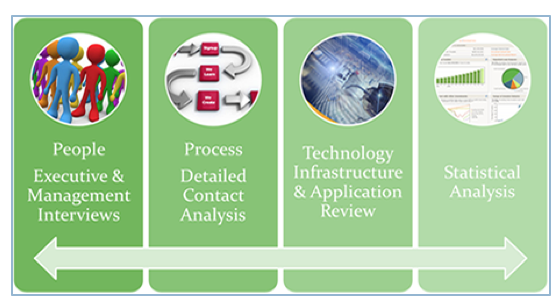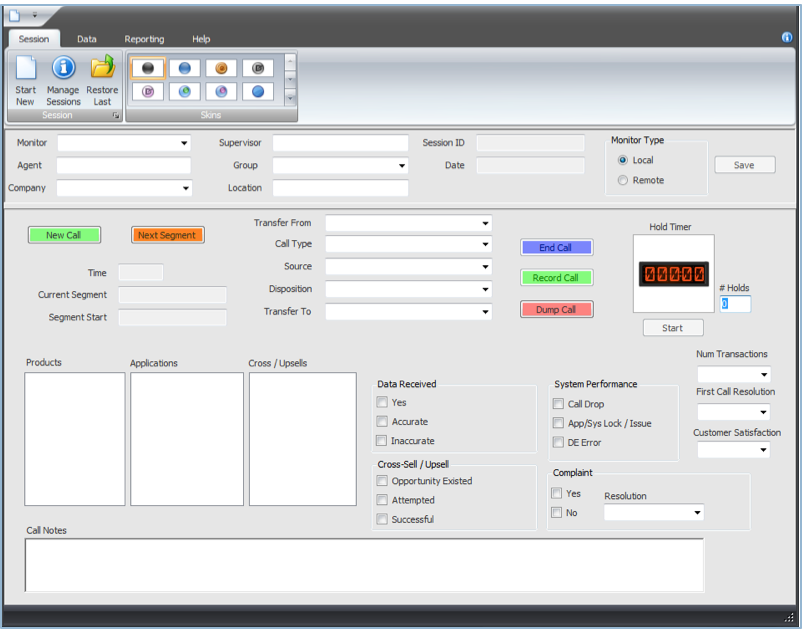Overview
Our Contact Center Performance Assessment (“CCPA”) is completed through the execution of four (4) inter-related work streams which have been designed to analyze, document, and quantify the organization’s application of people, process, and technology to provide exceptional customer service and support to the organization’s customer base.

Organizational Assessment
The Organizational Assessment is conducted to gather information on the organizational structure and processes related to contact center operations. This analysis may include the following components:
- Executive and Contact Center Management Interviews
- These interviews are designed to develop a better understanding of the organizational goals and objectives as well as known issues which may be impeding the company’s ability to achieve its customer service and support objectives. The analysis may also provide input to other work streams by shedding light on the contact center’s function and structure (number of contact centers, number, and types of agent groups, call volumes, customers served, products and services offered and/or supported, etc.).
- The management interviews include contact center management and supervisory personnel to develop a better understanding of the contact center’s operations at a staff-level. The purpose of these interviews is not to identify or address specific management issues but rather to develop an understanding of the issues impacting the center and the services the center provides.
- Training and Quality Assurance
- The analysis includes a review of how training is provided and maintained within the contact center and the degree to which training is incorporated into on-going quality assurance programs.
- Additionally, an analysis of the organization’s quality programs and processes may be included to help determine the degree to which quality is measured and maintained with regard to best practices.
- Contact Center Staffing, Scheduling, and Schedule Adherence
- This portion of the analysis is designed to develop a better understanding of how call center staffing is achieved, as well as how effectively schedule adherence is maintained.
Detailed Contact Analysis
The Detailed Contact Analysis is designed to collect a statistically valid sampling of calls through a combination of direct, side-by-side call observation and analysis of recorded calls. The direct observations of calls across all agent groups enable the team to develop an understanding of how calls are processed, including what applications are used, how effectively technology and call processing is applied, what issues the agents typically face during the progress of a call, and how effectively customers are served.

The tools used to analyze and document call processing (one of which is shown above) allow the team to break the calls down into pre-defined call segments to enable a detailed analysis of call processing. These segments may be customized to meet the needs of the client’s organization but generally include the following:
- Greeting/Customer Identification
- Who is calling
- Customer Validation
- Is the caller authorized to obtain service and what relationship does the caller have with the organization?
- Service Identification
- What type of service does the caller require (e.g. how can we help them)
- Service Delivery
- All activities related to addressing the caller’s needs.
- Call Wrap
- All activities related to ensuring that the caller’s needs have been fully addressed.
- After-Call Work (ACW)
- Any work the agent is required to do to document and/or complete servicing after the caller has disconnected.
For each segment of the call, the call monitor will use the call monitoring application to track detailed call information which may include the following:
- Call Type
- Call Source
- Call Disposition
- Whether or not data was received with the call and if it was accurate
- How the agent handled the call
- Whether or not the call was related to a complaint and how it was handled
- Whether or not a cross-sell opportunity existed and if the agent responded to it correctly
- Whether or not data entry errors occurred
- Whether or not system, application, telephony or other issues impacted the call were encountered
- Additional call notes and observations
All data collected through the course of the analysis is stored in a database and used to provide a detailed call handling analysis which will be included as a part of the analysis deliverable.Technology and Infrastructure Analysis
Technology Assessment
The technology infrastructure and application portion of the analysis is designed to develop an understanding of the infrastructure and applications used to support contact center operations including, but not limited to, the following:
- ACD / PBX system configuration and utilization
- IVR prompting and automation
- Call monitoring and recording
- Computer Telephony Integration (CTI)
- Scheduling systems
- CSAT systems
- Customer Relationship Management and/or other servicing applications
- Use of common applications such as email, chat, document processing and other tools
- Integrated Performance Management or other reporting & analytics tools
The analysis is not designed to validate or recommend the use of these systems but rather to determine the degree and manner to which they are leveraged to service customer contacts in the current environment.
Statistical Analysis
The statistical analysis portion of the review is designed to gather specific system reporting data that will be used to augment call analysis collected during the side-by-side observations. Typically, this analysis includes collecting data from the following systems:
- ACD Reports (agent utilization, queue/skill reports, call handling/performance reports, etc.)
- IVR application reports/peg counts
- Scheduling data
- Quality monitoring reports/scorecards
- Agent Cost Data
Information gathered through the statistical analysis will be combined with that of the detailed contact analysis to extrapolate detailed interaction handling costs and related performance.
Associated Deliverables
The deliverables that are typically associated with this project include the following:
- Detailed findings
- Recommendations
- Roadmap and recommended timeline to implement recommendations
How the CCPA benefits your organization
The CCPA is designed to provide both a broad and deep view of how the contact center organization is performing as well as what specific organizational, technology or business process-related functions are contributing to that performance (both positively and negatively).
We often recommend conducting the CCPA to support the following:
- When there are known or perceived performance issues in the contact center
- As a precursor to major contact center or other CX-related systems refresh or enhancement
- Prior to initiating an RFP (Request for Proposal) for contact center infrastructure or applications
Typical CCPA Duration and Resource Commitment
In most cases, the CCPA project can be completed in approximately 6-8 weeks. As with all of our services, we strive to engage our client’s teams and resources to the greatest extent feasible in the execution of the CCPA. The most resource-intensive portion of the project is the detailed contact analysis phase which typically requires up to 4 weeks to complete assuming a staff FTE of 4-5 people. The client is encouraged to provide as many of these resources as possible (tools and training will be supplied) in order to drive understanding and acceptance of the resulting findings. If the client is unable to provide resources, we will do so.
For the CCPA and all other services, we strive to keep all team members and stakeholders apprised of the progress of the project throughout the engagement. At a minimum, readouts of the initial (preliminary) findings will be conducted at the end of the data collection phase followed by a second readout and review once the findings have been finalized. Similarly, reviews will be conducted with key stakeholders and client team members after the first draft of recommendations and again when the recommendations are finalized. Similar reviews will be conducted for the final phase of the project during which the roadmap and recommended timeline for implementation are developed and reviewed with the client.

